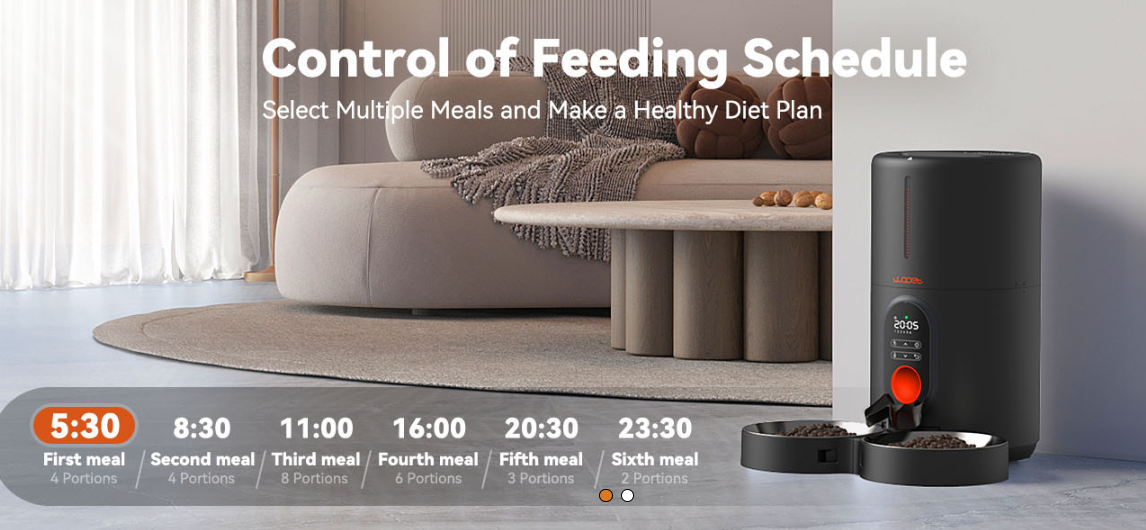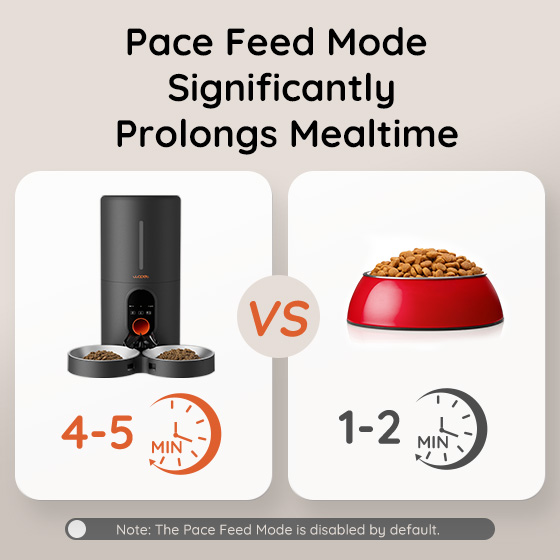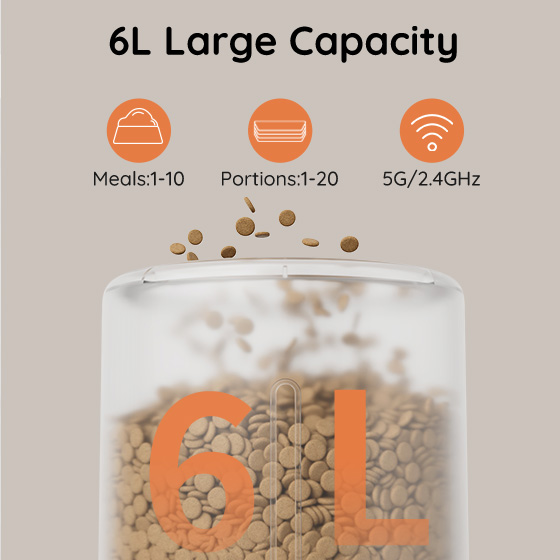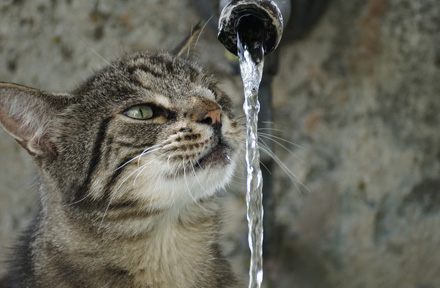Mar 20, 2025
Author:Lisa Martinez
Are you still struggling to choose the right food for your dog? Well, this article can help you! The choice you make for your dog’s food is as important as it is for your own food! This is something that directly influences their health and happiness.
The question is, how do we choose the right food ingredients?
It’s difficult to figure out what truly is high-quality - provided that all the clever marketing tactics and labels will always keep you confused. This might come as a shock - but even commercial pet foods have quite a lot of dangerous ingredients in them. With WOpet’s automatic pet feeders, you can ensure your dog gets properly portioned meals without unnecessary additives or fillers.
Let’s talk about three harmful food components that are present in your dog’s foods today. You need to figure those out - to prevent your dog from getting sick.

Artificial preservatives such as BHA (butylated hydroxyanisole), BHT (butylated hydroxytoluene), and ethoxyquin are synthetic additives used in pet foods to help them last longer on the shelf.
By stopping fats from going bad naturally, these chemicals make it possible to produce large batches of food that can be stored for extended periods. You’ll often spot these preservatives in budget-friendly kibble options that are marketed as “complete nutrition” at appealing prices.
For instance, popular brands like Ol’ Roy, Kibbles ‘n Bits, Iams, and Pedigree frequently use ingredients like BHA or BHT to keep their products fresh behind the scenes. Canned pet foods also rely on preservatives to avoid spoilage, with ethoxyquin still appearing in some recipes, often labeled simply as “a preservative.”
The trouble lies in the fact that these synthetic additives come with questionable side effects ranging from allergy irritation to organ damage and disease risks at accumulated doses. Studies link BHA/BHT consumption to thyroid, liver, and kidney impairment along with cancer development in animals over time.
These chemicals accumulate in tissue with continued exposure—a phenomenon called bioaccumulation. The common industry argument that “the dose makes the poison” fails to account for this progressive effect leading to cellular mutation and disruption of biological pathways.
Similarly, FDA-approved pesticide residue ethoxyquin has ties to DNA damage, reproductive issues, and reduced lifespan per research findings. While banned from human use, this chemical continues to appear in pet food despite links to liver dysfunction and behavioral changes indicative of pain or susceptibility.
Given their associated risks, why do pet food manufacturers continue using synthetic preservatives like BHA, BHT, and ethoxyquin? Simple...because they extend shelf life efficiently at a low cost!
Artificial preservatives allow companies to manufacture infrequently in large batches, stockpile inventory, and distribute mass quantities nationally without reformulation for 6 months or longer before “best by” dates hit. This keeps production efficient and unit costs down.
Prey diet proponents argue dogs evolved eating fresh foods naturally preserved by nutrient density rather than chemicals. They point to how artificially extending shelf life caters more to retail and distribution logistics than optimizing nutrition at the peak of biological potency.
Seeking out dog food without BHA, BHT, ethoxyquin and other artificial preservatives avoids associated health risks—both proven and speculative. Several boutique, small-batch, and newer national brands now create pet food preserved with natural antioxidants like vitamin E, vitamin C, and rosemary instead of chemicals.
Brands like Instinct, Orijen, Nature’s Logic, Wellness CORE, and Blue Buffalo Wilderness all make their dog food without artificial preservatives. So healthy, more transparent options exist in today’s market. Switching to a fresh food diet from brands like NomNomNow or The Farmer’s Dog also dodges preservatives entirely.
As always, check the ingredient panel listing and product details carefully when assessing pet food quality. Seek out specifics on what’s used to maintain freshness without just accepting generic terms like “a preservative”. Consider consulting your vet for tailored input based on your dog's health needs.

Meat by-products consist of leftover animal parts deemed unfit or excess for human consumption. Organs, lungs, bones, blood, hooves, and unspecified “meat” scraps make their way into feed-grade material from slaughterhouses and rendering plants annually.
Collectively called “by-product meal” or “animal by-product meal”, these remnants frequently end up as cheap concentrated protein sources in budget-minded dog foods.
Mass-market brands like Pedigree, Purina Dog Chow, Ol’ Roy, and Beneful all incorporate by-product meals within initial ingredient panels on bags. This allows them to boost stated protein percentages without resorting to muscle meat cuts—a cost-saving shortcut.
Listing generic terms like “poultry by-product” or “meat by-products” without specifics on organ or part sources means virtually anything goes compositionally. The remnants can change from batch to batch. So while dogs may enjoy the taste, what’s actually in that “meaty” kibble or tin remains a mystery!
The trouble with by-product ingredients lies in their inconsistent nutritional quality and sourcing transparency issues. These cumulatively take a toll through exposure over months and years of eating by-product-based dog foods.
Contaminants and toxins pose a risk depending on the materials rendering plants receive and process. Studies show concentrations of heavy metals in pet food containing by-products. Pentobarbital residues (euthanasia agents) have also triggered recalls after entering the rendered material supply chain unexpectedly.
Beyond chemical dangers, digestibility and assimilation come into question when dogs eat by-product meals long-term. Irregular digestion and elimination, flatulence, vomiting, or diarrhea all connect to low-grade protein intake.
By-products tend to be highly processed at high temperatures as well—potentially creating carcinogens like heterocyclic amines in the cooking process.
Continued usage of rendered protein meals in pet foods relates to keeping ingredient costs down at scale. By some estimates, a rendered by-product blend can cost 75% less than its equivalent in butcher shop animal parts. Pet food brands buy this material in huge quantities as the primary protein delivery mechanism for budget-focused recipes.
Manufacturers can utilize loosely defined terms like “meat by-products” generically without specifying cuts or organs thanks to loose regulations around allowable compositions. This flexibility keeps sourcing flexible on the supply side—but leaves consumers guessing on the demand side.
Presently in the US, no organization certifies or vets renderers and by-product meal quality traces only to the end-producer. Yet worrying about what might be included from batch to batch proves difficult for the average pet owner. Instilling consumer confidence through enhanced transparency could spur changes industry-wide.
When selecting a dog food brand, prioritizing whole meat ingredients rather than by-products provides a quality upgrade. Seeking out regional companies advertising their local, trusted suppliers offers another way to improve transparency.
Some newer brands focus entirely on whole-prey ratios without any rendered meals. Considering fresh dog food delivery also often increases focus on whole-muscle meats. Taking time to understand sourcing and production methods makes selecting a healthier option easier regardless of specific diet type.
Consulting veterinarians to match food based on your dog’s needs and sensitivities is also advised. No matter what, check the ingredient panel listing on any dog food closely for specifics before purchase. Avoiding generics like “by-product meal” takes a bit more diligence but pays off through improved health over time.

Grains like corn, wheat, soy, sorghum, and rice serve as fillers providing cheap calories (and carbs) rather than dense nutrition in many dry dog foods. Added for their cost factor and binding properties, these controversial “energy sources” supply substantial bulk to complete low-cost kibbles.
Beneful, Purina Dog Chow, Iams, and other big commercial brands packing filler-focused recipes bank on the fact that legally, dog food need only deliver complete proteins and fats by the end—not within every ingredient alone. This gray area allows manipulating ratios to hit minimums rather than optimize.
Unfortunately, fillers displace more beneficial ingredients delivering vital fatty acids, amino acids, vitamins, and minerals inherently. Binding agents like corn, wheat, and soy ultimately provide empty calories disproportionate to canine biological needs. Dogs lack the digestive enzymes to properly metabolize grains and plant material compared to carnivorous predecessors.
The cumulative toll of high-grain diets shows up through disrupted digestion, nutrient deficiencies, weight gain, lethargy, and inflammation in dogs over time. Carb-loaded foods also connect to allergy triggers like itchy skin, ear infections, and other immunological issues when fed chronically.
Per clinical veterinary findings, grain-based ingredients often cause or intensify health problems in dogs—especially pure breeds prone to sensitivities. Diets with corn and wheat are linked to higher rates of diabetes, arthritis, and obesity as well. Dogs eating significant grain portions experience more tartar buildup and dental problems too.
Ultimately fillers overburden canine digestion while failing to deliver meaningful nutritional value. These cheap calories tax the gut, displace better nutrients and set the stage for inflammation and future disease. Sustained filler overload strains the system.
Filler-focused recipes allow major pet food manufacturers to produce enormous product volumes cheaply. Corn, wheat, soy, and rice all cost a fraction compared to quality cuts of muscle meat, for example. When making dog food by the tons, this cost factor really adds up—saving millions in expenses annually industry-wide.
As binding agents, grain and plant fibers also hold kibble together during extrusion and help automated production run smoothly.
Manufacturers claim ingredients like corn still provide a good energy source meeting basic canine nutritional needs on paper. Fair arguments—yet the disproportionate ratios to meat proteins deviate from ancestral canine diets.
When selecting a dog food brand, considering grain-free options or those with limited whole grain amounts only provides an upgrade.
Seeking out alternative carbohydrates like sweet potatoes, peas or tapioca in place of corn and wheat can benefit dogs sensitive to grains. Some recipes also tout high meat percentages for closer macronutrient parity to prey-based diets.
Several boutique, veterinary, and fresh pet food brands now offer grain-light or carbohydrate-conscious recipes catering to ancestral canine needs instead of filler-loaded ones. Wellness Core, Instinct, The Honest Kitchen, NomNomNow, and JustFoodForDogs all provide healthier alternatives.
As always though, check labels to identify filler and carbohydrate levels to determine quality and suitability. Consulting a canine nutritionist or veterinarian for tailored advice is also recommended.
In commercial dog foods, you might avoid the three ingredient categories, artificial preservatives, meat by-products, and filler content. These are not good for your pet, and you should try to avoid them as much as possible.
As a dog owner, it’s crucial to figure out labeling terms, sourcing standards, processing methods, and nutritional guidelines. This knowledge is a key first step in ensuring your dog’s health through their diet.
It’s not just about knowing what’s in their food; it’s also about understanding the reasons behind those ingredients and how they’re processed.
Support your dog’s health with the right food choices and a structured feeding schedule. Ensure portion control and consistency with WOpet—because every meal matters!
Label:
Popular Post

What to Feed a Sick Dog With No Appetite? [2025 Guide]
May 16, 2023

Troubleshooting Common Issues with Automatic Pet Feeders: Tips & Tricks for Pet Owners
Oct 26, 2023

Why Does My Cat Cough After Drinking Water? 8 Potential Reasons
Mar 13, 2023

My Cat Only Eats A Little at A Time - What to Do?
Feb 27, 2023

Why is My Cat Throwing up Water? Top 5 Causes Here
Feb 08, 2023
$99.99
$129.99
Copyright © 2025 WOPET. All Rights Reserved.